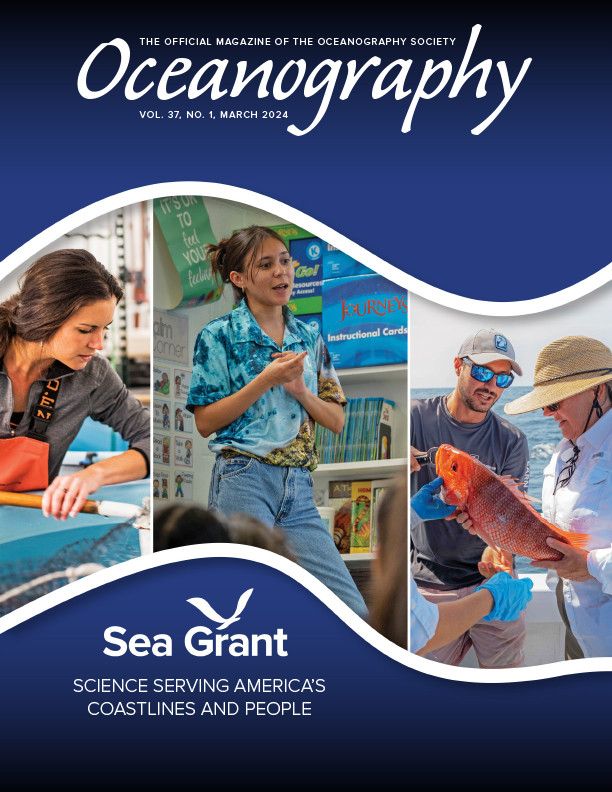Introduction
Professional development (PD) programs provide opportunities for teachers to deepen their content knowledge and develop a strong foundation for teaching their subject matter—especially in such a rapidly evolving field as STEM. High-quality teacher PD has been shown to result in greater student success (Darling-Hammond et al., 2017; Robinson, 2019). Teacher PD can include expanding teachers’ knowledge and skills, introducing state-of-the art technologies, providing customizable lesson plan ideas, encouraging inclusive practices, sharing research-based pedagogical strategies, promoting peer-to-peer interactions/networking, and developing teachers as leaders. Common outcomes of teacher PD, as self-reported by the participants, include new ideas for instructional strategies, resources for classroom lessons, better understanding of real-world science and engineering, renewed motivation and enthusiasm for teaching, expanded professional networks, and increased confidence. All of these factors combine to raise the quality of instruction and therefore student learning.
In this paper, we share four very different examples of STEM teacher PD that incorporate these recommended practices. The audiences vary, ranging from K–12 teachers to college faculty to future faculty (graduate students). The content also varies, encompassing technical training, content knowledge, and “soft” skills. We summarize the four projects here, and then provide more detailed descriptions below.
PROJECT 1. Place- and Community-Based Teaching in Hawai‘i, supported by Hawai‘i Sea Grant and the US National Science Foundation, aims to increase the comfort level (and therefore the likelihood) of University of Hawai‘i geoscience faculty in incorporating place- and community-based teaching practices into their classrooms. This project aligns with the university’s goal of becoming a Native Hawaiian Place of Learning.
PROJECT 2. Aquaculture in Action, a Maryland Sea Grant/University of Maryland Extension program, serves as a model for aquaculture education in the classroom, based on the principles of project-based learning, and provides cross-disciplinary, student-driven opportunities that emphasize its strength as a tool for teaching STEM disciplines.
PROJECT 3. SeaPerch II, created by MIT Sea Grant, provides technical training to elementary, middle school, and high school teachers across the United States and around the world in engineering, robotics, and ocean science. Teachers then work with students to build their own customized instruments and deploy them on research missions.
PROJECT 4. Virginia Scientists and Educators Alliance (VA SEA) provides mentoring in science communication and K–12 lesson plan design to future faculty (graduate students), as well as ocean science content knowledge for classroom teachers.
What these four projects have in common is their investment in teacher PD. They set current and future instructors up for success by immersing them in experiential learning and providing essential connections to current research that can help motivate new curricular ideas and instructional strategies that enhance instruction. A key theme is collaboration, whether with formal educational organizations, community groups, or other Sea Grant offices.
PROJECT 1. Place- and Community-Based Teaching in Hawai‘i
Barbara C. Bruno ([email protected]), Jennifer Engels, and Daniela Böttjer-Wilson, University of Hawai‘i at Mānoa
This collaboration between the School of Ocean and Earth Science and Technology (SOEST) and the Center for Teaching Excellence aims to foster a culture of place- and community-based teaching (PBT) practice at the University of Hawai‘i (UH) at Mānoa, rooted in both Western science and traditional knowledge. PBT has been shown to improve student learning, increase student interest and motivation, promote strong relationships with local communities, and cultivate environmentally conscientious citizens (Böttjer-Wilson and Bruno, 2019, and references therein). A 2018 survey indicated strong interest in bringing PBT into SOEST classrooms: 78% of student and 83% of faculty respondents reported that PBT is an important and effective practice to reach all students. In response, we developed and delivered six workshops to provide faculty with the knowledge, skills, and confidence necessary to implement PBT in their classrooms.
Here, we provide a summary of the six workshops along with highlights of the evaluation results. All workshops were team taught and ranged from 75 minutes to 3 hours in length; all but one were virtual due to COVID: (1) Fostering a Sense of Place & Community in Virtual Classrooms was a panel discussion on approaches and strategies for bringing place and community into virtual classrooms. (2) Sharing Mo‘olelo (stories) and Community Virtually Through Storymaps used online tools that combine interactive maps with multimedia content to showcase an urban agriculture collaboration between farm owners and UH researchers that incorporated data from traditional knowledge sources. (3 and 4) Papakū Makawalu workshops on Wai (water) and Mahina (moon) shared a Hawaiian worldview akin to Earth systems science, led by cultural practitioners at the Edith Kanaka‘ole Foundation. (5) Campus Huaka‘i (fieldtrip) interwove Hawaiian cultural, historical, and geological perspectives of the Mānoa campus through a walking tour (Bruno et al., 2022). (6) Place-Based Teaching for Equity and Belonging stimulated faculty discussion about using PBT, such as land acknowledgments and mo‘olelo, to increase undergraduate persistence.
In post-workshop evaluations completed by faculty participants, on a scale of 1 (low) and 5 (high), the mean ratings of the workshops were 4.76 (overall usefulness) and 4.78 (overall content). The evaluation survey also asked participants to share the specific strategies employed in the workshop that they found most helpful. Here is a sampling of their verbatim responses:
- Framing sense of place from a Native Hawaiian perspective
- Seeing science in the chants by looking at different translations and multiple meanings of words
- Understanding more about how Papakū Makawalu is a process for deconstructing and reconstructing what we kilo [observe] around us, rooted in the kumulipo [Hawaiian creation chant]. Interesting and helpful for thinking through how knowledge is created and organized and shared.
- Looking at campus through such an interdisciplinary lens added a lot to my understanding and sense of place here. I was curious about the “less told history,” but didn’t know where to start looking until yesterday.
- Getting such great information and realizing that it would be possible for me to lead a fieldtrip with my students that doesn’t just cover Western science perspectives but also Hawaiian culture and history. This is exciting!
- The speakers’ capacity to help participants imagine and realize how identified activities might be tailored for use across fields of study.
In their open-ended comments, participants self-reported feeling more culturally connected and articulated plans for making their class content more place based. We are encouraged by these results and hopeful that this will ultimately translate into improved student learning outcomes.
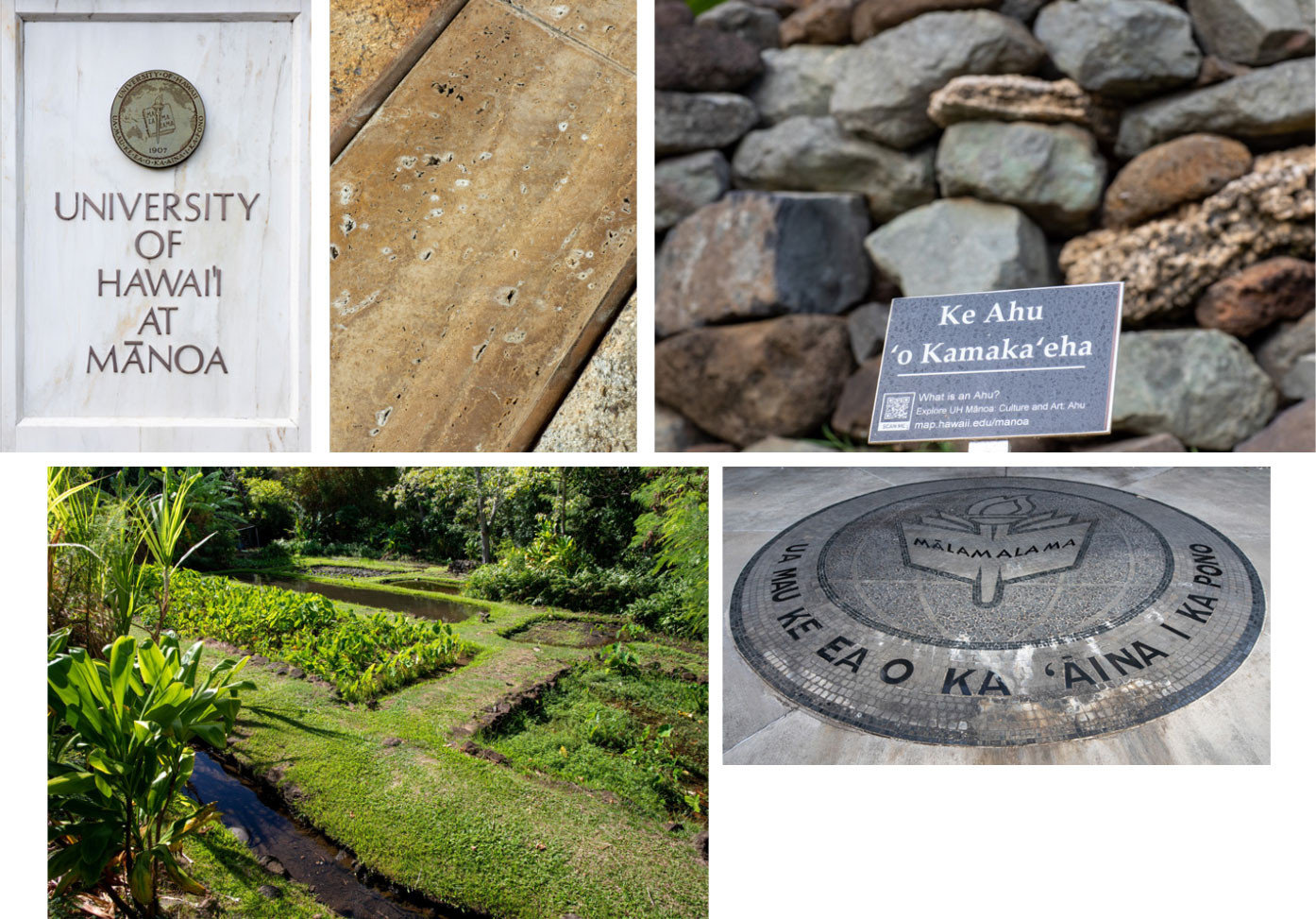
FIGURE 1. The University of Hawai‘i huaka‘i (walking tour) of the Mānoa campus interweaves Hawaiian cultural, historical, and geological perspectives. Credit: Hawkins Biggins. > High res figure
|
PROJECT 2. Aquaculture in Action – Tools for Teaching Science
John Adam Frederick ([email protected]), Jacqueline Takacs, Chris Flight, and Amy Lang, Maryland Sea Grant/University of Maryland Extension
Aquaculture, specifically recirculating aquaculture systems (RAS), is an increasingly useful interdisciplinary educational tool for students and teachers and is an excellent vehicle for project-based learning (PBL). Aquaculture is highly motivational, generates interest across all learning abilities, and promotes improvement of ocean and environmental literacy. Students apply a wide range of skills in a variety of classroom and lab-based settings and participate in “hands on” applications of physics, biology, chemistry, engineering, and mathematics skills that can be related directly to curriculum at the local level, classroom lesson plans, and education standards. Such skill-based experiences are critical in all aspects of science education today as school systems attempt to keep pace with rapidly expanding technology and growing economic sectors of applied sciences like aquaculture and aquaponics. By directly working with teachers and administrators to enhance curriculum choices, global scientific issues can be addressed, and appropriate instructional strategies can be developed for teacher PD and ultimately programs that focus on student-driven participation in STEM.
Maryland Sea Grant and University of Maryland Extension have developed an education and PD program for K–12 science teachers called Aquaculture in Action (AinA; https://www.mdsg.umd.edu/topics/k-12-aquaculture-education). Initiated in 1996, in partnership with the Carroll County Public Schools (CCPS) in Maryland, it has become an essential component of the innovative CCPS elective course called Science Research. This model has expanded to all CCPS high schools and to many middle schools and has become a frequent destination for other K–16 educators from around the United States to learn how RAS can be used as a model for PBL, for the study of native species of fish, and for the use of RAS management techniques in the classroom (Frederick, 2005).
The AinA model provides a learning experience for both educator and student that helps form life-long relationships with local aquatic species within the Chesapeake Bay watershed and literacy skills associated with aquaculture, one of the fastest growing sectors of agriculture in the United States. Today, AinA is being implemented in 31 schools across eight Maryland counties and Baltimore City. AinA is an educational component of projects funded by the Recirculating Aquaculture Salmon Network (RAS-N) and Sustainable Aquaculture Systems Supporting Atlantic Salmon and has helped restock over 10,000 native fish to local waterways. Additionally, many thousands of students have had hands-on participation within this unique CCPS program over the last 25 plus years. Although the quantitative impact of this program is difficult to measure, the qualitative impact is evident through the participation of the students in the design, construction, and management of RAS for the purpose of studying local species.
Essential partners in this work include the Institute of Marine and Environmental Science in the Rita Rossi Colwell Center in Baltimore, Maryland, and the Maryland Department of Natural Resources. These institutions are critical links in keeping pace with the advancement of technology used as a model for AinA RAS development (Frederick and Takacs, 2015) and the supply of native species of fish for the classroom. Additionally, these two partners have collaborated with Maryland Sea Grant to rear fish over the summer months in preparation for distribution to schools at the start of the academic year. Efforts such as these help to minimize the burden of maintaining RAS on school sites by local teachers over the summer months and help to ensure a healthy stock of fish for the classroom. Also, this partnership has enabled teachers and students to raise native species of seahorses and horseshoe crabs in addition to a number of fish species. Recently, expansion of the AinA program has included new schools in Baltimore City and efforts through the US Department of Agriculture grant-funded projects to expand programming in University of Maryland Extension 4-H to introduce students to small-scale aquaculture and aquaponics system design and increase their skills and creativity in student-driven projects.
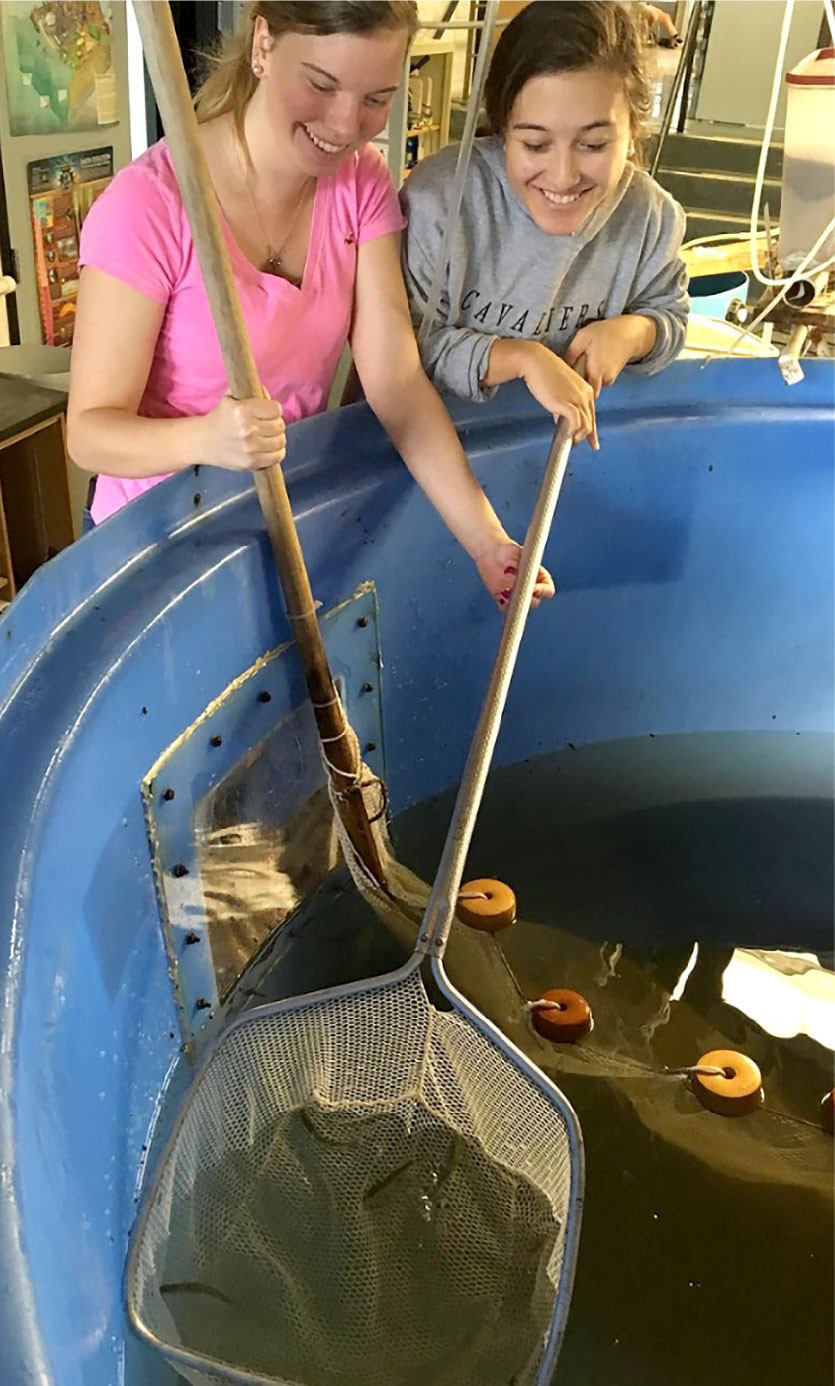
FIGURE 2. Two students use a seine net and a dip net to isolate native species of fish for release into a local stream. Photo credit: J. Adam Frederick. > High res figure
|
PROJECT 3. SeaPerch II – The Next Generation Ocean Engineering and Education Program
Robert Vincent and Andrew Bennett ([email protected]), Massachusetts Institute of Technology, Sea Grant College Program
SeaPerch is a simple, underwater remotely operated vehicle (ROV) made from PVC pipe and other inexpensive, easily available materials. The SeaPerch Program, created by MIT Sea Grant in 2003, trains educators across the United States and around the world in engineering, robotics, and ocean science. Educators can leverage the SeaPerch to teach ocean science, ocean engineering, and climate change and even use the SeaPerch as a springboard into subjects such as seafaring literature, topics in math and physics, and the history of underwater exploration. The hands-on SeaPerch experience is a gateway to further study and careers in robotics, engineering, marine sciences, and more. Since its inception, the program has continued to grow and is popular internationally through the SeaPerch Challenge, organized by RoboNation.org. Building upon this, MIT Sea Grant has developed SeaPerch II, the next generation. SeaPerch II incorporates updated technology along with sensor construction and attachments to monitor ocean variables and expand on ocean science, engineering, and education principles, training the next generation of ocean engineers and scientists.
In response to the increasing importance of computer science since SeaPerch’s early development, MIT Sea Grant is using SeaPerch II to establish a roadmap toward autonomy by creating a series of modules that build on each other. Since the design of SeaPerch’s curriculum, there have been major advances in microprocessing capabilities, resulting in lower barriers to use. SeaPerch II employs the user-friendly, open-source interactive Arduino hardware and software to help students understand the construction of circuits and basic programming principles. Much like SeaPerch’s well-established community infrastructure, Arduino has a rich volume of resources that students can reference to help them innovate with their ROV designs. The Arduino module provides a solid foundation for electromechanical systems without sacrificing any of the original benefits and capabilities of the original SeaPerch program. To aid educators, each SeaPerch II Module is accompanied by a Build Guide and a Science/Technology Notes Guide filled with materials for educators. Topics range from how to make and cast silicone to biomimicry and how to filter sensor data. All materials are posted publicly at https://seagrant.mit.edu/seaperch2/. Additional modules and topics are added to the website on a regular basis.
Future SeaPerch II modules will also allow students to experiment with state-of-the-art soft robotic technology, which was inspired by biomimetics (e.g., soft bodies, tentacles) and has far-reaching applications for mobility and sample collection, especially piquing the interest of the marine sector. MIT Sea Grant is developing silicone-based soft robotic modules for gripping actuation that aim to introduce students to this emerging paradigm in robotics. The most accessible versions of the soft robotics module will only require standard classroom supplies along with easily obtained castable silicone. By covering the fundamentals of soft robotics, we hope to encourage students to design, prototype, and test their own soft robotic actuators. The modules will prepare students for soft robotics’ increasing prevalence as a technology with societal applications.
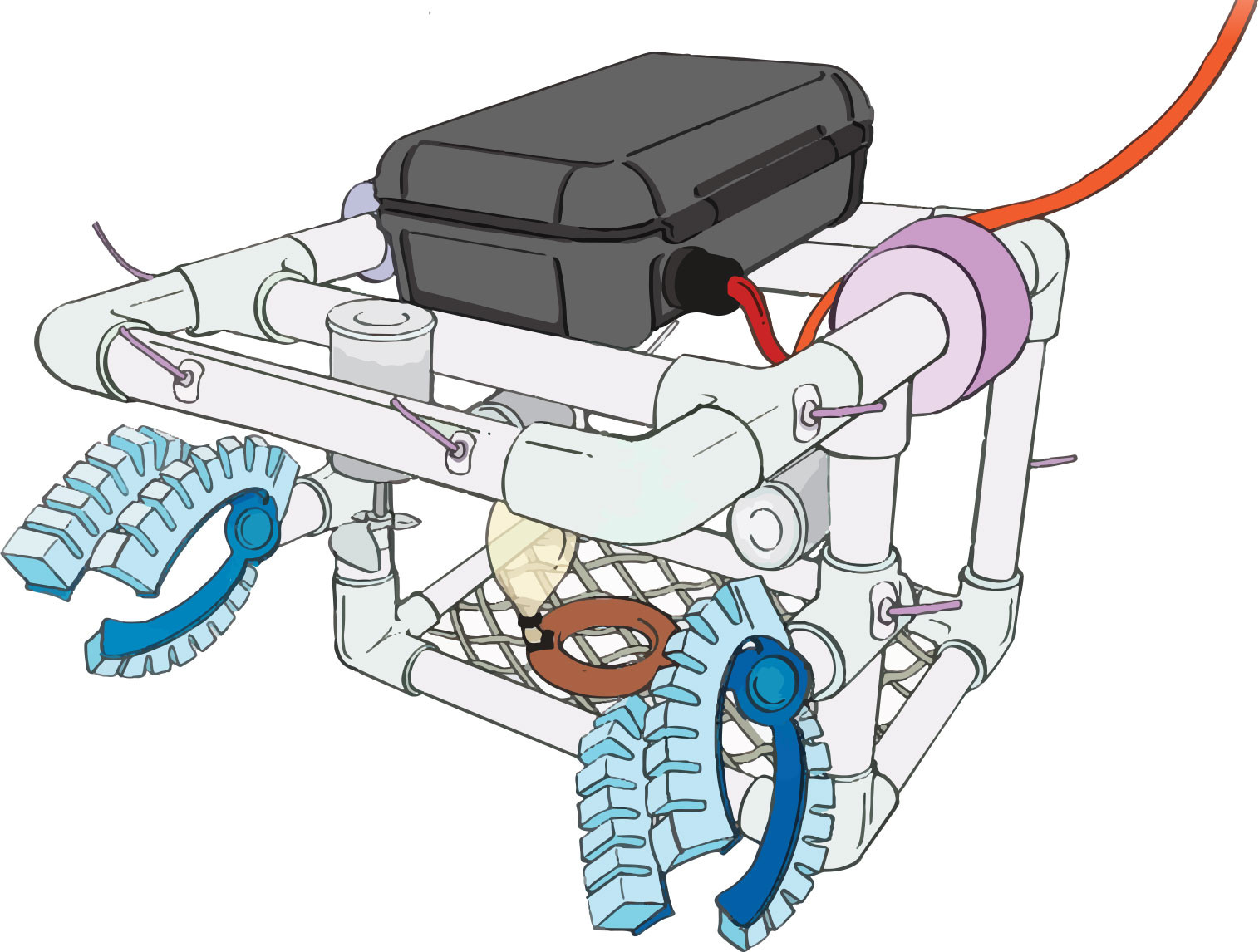
FIGURE 3. Artist representation of a SeaPerch II ROV with soft robotic and depth modules attached. Illustration by Danlei Huang. > High res figure
|
PROJECT 4. The Virginia Scientists & Educators Alliance (VA SEA) – Translating Graduate Student Research into Engaging Classroom Content
Celia Cackowski ([email protected]), Lisa Ayers Lawrence, Bethany Smith, Virginia Institute of Marine Science, Marine Advisory Program/Virginia Sea Grant Extension
Launched in 2015, the Virginia Scientists & Educators Alliance (VA SEA) is a network of marine science graduate students, classroom teachers, and informal educators whose goal is to translate emerging ocean science into engaging, inquiry-based lesson plans. With names like “Bye, Bye, Bycatch!” and “Sea Turtle CSI,” VA SEA lessons help link classrooms with cutting-edge marine research, allowing middle and high school students to investigate the same questions as professional scientists.
Developed by educators from the Chesapeake Bay National Estuarine Research Reserve in Virginia (CBNERR-VA) and the Virginia Institute of Marine Science’s (VIMS) Marine Advisory Program, VA SEA is currently funded by NOAA through the National Estuarine Research Reserve Science Collaborative. Its mission is twofold: to develop high-quality K–12 classroom resources and to give graduate students practical experience in communicating their work to public audiences.
Now in its seventh year, VA SEA facilitators have developed a tried-and-true formula. In late summer, participating graduate students attend a series of pedagogy workshops and meet with a panel of science teachers to discuss best practices for creating engaging classroom activities. Following these workshops, participants attend small-group check-in meetings to bounce ideas off their fellow participants and VIMS staff educators. Once a topic is selected, participants work one-on-one with VIMS educators throughout the fall semester to hone their lessons.
At the end of the fall semester, draft lessons are sent to local classroom teachers to pilot with their students. Participants are given feedback from these teachers early in the spring semester and then refine their lessons based on the comments and suggestions received. Once their lessons are finalized, the activities are reformatted and showcased in a science-fair style Lesson Plan Expo. These expos, held annually in late April, afford graduate students the opportunity to present live demonstrations of their activities, interact with the teachers who will be using them, and answer any questions they may have.
As of spring 2023, more than 65 graduate students from five Virginia Sea Grant partner institutions have participated in the VA SEA program. Lesson plans from the seventh cohort will be released in April, bringing the total collection to 75 classroom activities. To view the full downloadable lesson collection, visit https://vims.edu/vasea.
The VA SEA model was successfully adapted by Oregon Sea Grant in 2019, resulting in the Oregon Marine Scientist & Educator Alliance (ORSEA), and New Jersey and Florida Sea Grant began piloting their own versions in August 2023.
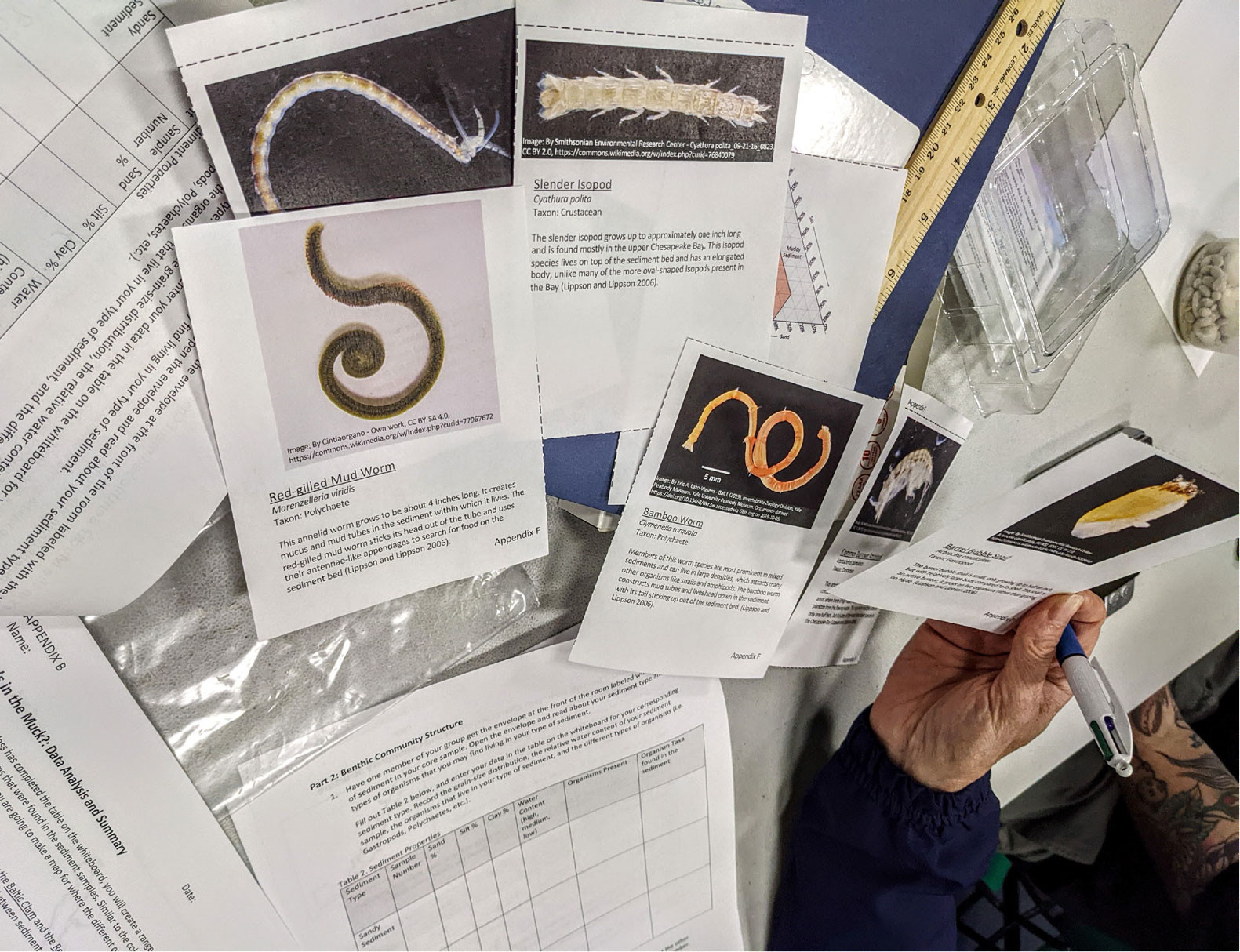
FIGURE 4. Teachers in a recent Ocean Literacy Workshop explore “What’s in the Muck?”—a high school lesson about benthic community structure written by VIMS graduate Cristin Wright. As of the 2022–2023 program year, VA SEA lesson plans had been downloaded more than 15,000 times by educators in 158 nations. Photo Credit: Celia Cackowski. > High res figure
|
Conclusions
This paper shares four Sea Grant-funded models in applied education programming from Hawai‘i, Maryland, Massachusetts, and Virginia. Through partnerships between educators and researchers, they keep teachers updated with current scientific knowledge, enhance their pedagogical skills, and enable them to implement evidence-based practices. Ultimately, this can lead to improved student outcomes and a stronger foundation for scientific literacy in future generations. The success of these approaches is evident from participant comments in evaluation surveys and unsolicited emails. For example, participants report that the trainings “Provided information I wouldn’t have found any other way. Very enlightening!” and “Hearing specific, practical strategies that I can bring into my class [was most helpful].” Participants also report that they were successful in subsequently applying the content and skills that they learned in the trainings into their classrooms. For example, “The program has brought greater variety into the classroom, more areas of science, greater diversity of teaching styles, plus real science career exposure for students [that they wouldn’t have had otherwise]” and “I’ve definitely used the skills that I acquired during these opportunities. I truly think they helped me to become a better communicator and educator. I even use them in everyday conversations with people when describing my research.”
Acknowledgments
This work was supported by the National Oceanic and Atmospheric Association (NOAA) through subawards managed by Hawai‘i Sea Grant, Maryland Sea Grant, MIT Sea Grant, and Virginia Sea Grant. Additional funding for the Hawai‘i project was provided by the National Science Foundation (NSF/GEO #2022937). Additional funding for the VA SEA project was provided by the National Estuarine Research Reserve Science Collaborative. The Aquaculture in Action program has had support from a number of resources, including the Chesapeake Bay Trust, The NOAA BWET program, The National Sea Grant Office, The National Marine Sanctuaries Foundation, and in-kind donations of RAS supplies and equipment from the National Aquarium, the Institute of Marine and Environmental Science, and the Maryland Department of Natural Resources.

